Qiu Jinxian: How can "painting Lang Zhong" re -see the ancient Chinese paintings?|
Author:China News Weekly Time:2022.07.15

Hope those who have been full of previous paintings and calligraphy
Can see the day through my hands
"Talk" with people who enter the museum
Let the world feel Chinese culture hidden in artworks

Author: Jin Xu
Number of full text: 3013
Estimated reading time: 10 minutes
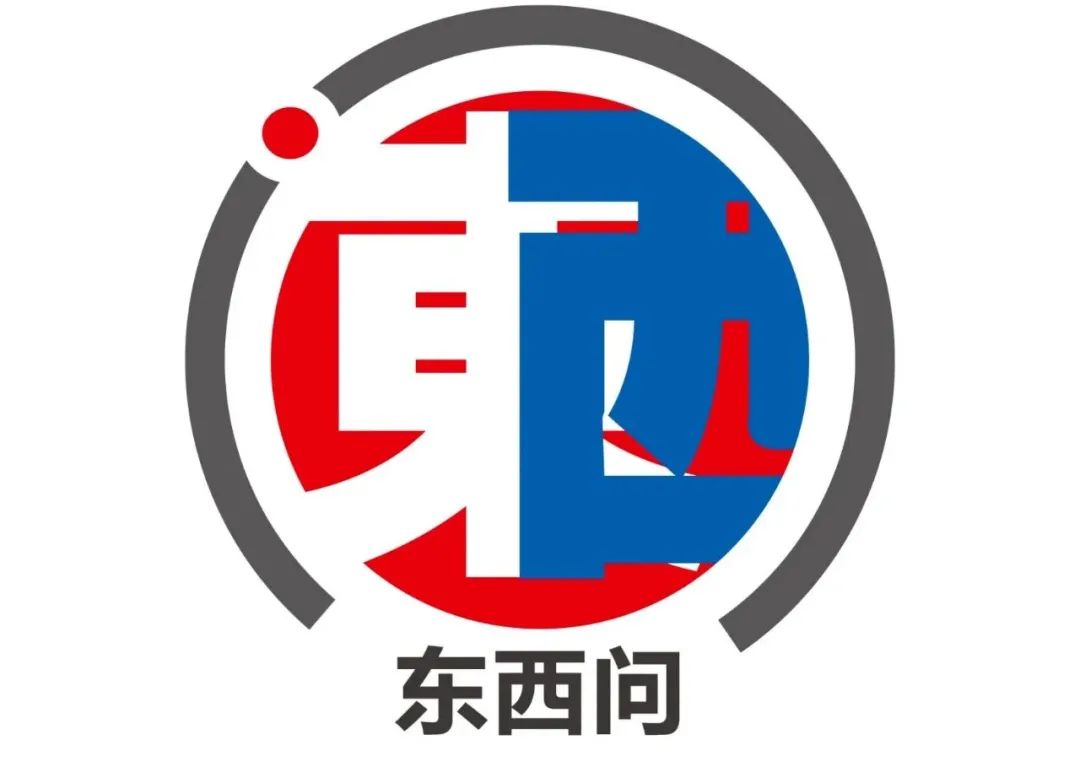
In the No. 91A exhibition hall of the British Museum, "Female History" is carefully treasured in a tailor -made display cabinet, with only 6 weeks of exhibition time each year. As the most famous Chinese calligraphy and painting collection in the museum, "Female History" also once "fragmented." Nowadays, spring silkworm -like painting brushwork and character image with both gods and gods attract many tourists to see the true appearance. Its new life is inseparable from the careful care of the ancient painting repair division.
As the first Chinese who entered the British Museum, Qiu Jinxian, a senior senior restorationist, "rescued" many important ancient Chinese paintings. Recently, she accepted an exclusive interview with China News Agency's "East and West Questions", telling how the ancient painting restorations of overseas paintings were used to use wonderful hands to remove the history of history, reproduce cultural relics in the past, how to continue the life of cultural relics with benevolence, so that history can be in a trace of one, one Pen's painting is preserved.
Abstracts are currently recorded as follows:
Reporter of China News Agency: Cultural relics repair division is described as a career of "choosing one thing, one life". In the 35th year of working in the British Museum, how many ancient Chinese paintings did you repair? What is the opportunity for you to choose to stay at the British Museum?
Qiu Jinxian: I have worked in the British Museum for so many years. The number of ancient paintings I have repaired has long been remembered. There should be more than 200 pieces of silk paintings from the Dunhuang Tibetan scriptures. There is still an unwanted Dunhuang painting in the collections. This pile of crisply crushed silk slices are placed in the box without moving to reproduce the contrast before and after the repair of ancient paintings.
In 1972, I entered the Shanghai Museum Mixing Painting Group. I learned from Xu Maokang and Hua Qiming, two masters, to learn mounting skills, and became the beginning of my painting and calligraphy repair career. In 1987, a London antique dealer had a lot of ancient paintings to be repaired. I also hoped to have the opportunity to understand the technology of foreign mounting paintings and increase their knowledge. So I agreed to work in the UK with the Shanghai Museum for two years.
By chance, I met the famous British sinologists and Chinese artist Professor Roderick Whitfield. From 1968 to 1984, he worked in the Oriental Ministry of the Greater British Museum (now the Asian Ministry) and was responsible for the management of ancient Chinese calligraphy and painting. After the recommendation of Professor Weituo, at that time, Professor Jessica Rawson, director of the East Department of the British Museum, invited me to demonstrate the traditional Chinese ancient painting repair skills. On that day, Professor Wei Tuo and Ms. Bai Zhen (currently the director of the Asian Ministry) in charge of managing Chinese cultural relics took two paintings to repair me, one of which was Fu Baoshi's "King Kong Po".
It took me two weeks to demonstrate Fu Baoshi's works. There were several big holes in this landscape painting. I first looked at the color of the painting. After determining that the water would not be faded, I decided to rinse with the boiling water on the front of the scroll. The staff present were very surprised. After five times of washing the painting, I unveiled the back paper behind the scroll, re -supported the life paper and put it on a good slurry. It is difficult to see the traces of repair after repair. The demonstration left them a deep impression.
After two years of staying in Britain, Professor Rosen said to me, "We need you too much. You are not there. There is no chance to see the sky in Chinese calligraphy and painting in the warehouse." So, I decided to continue to "rescue" ancient Chinese painting.
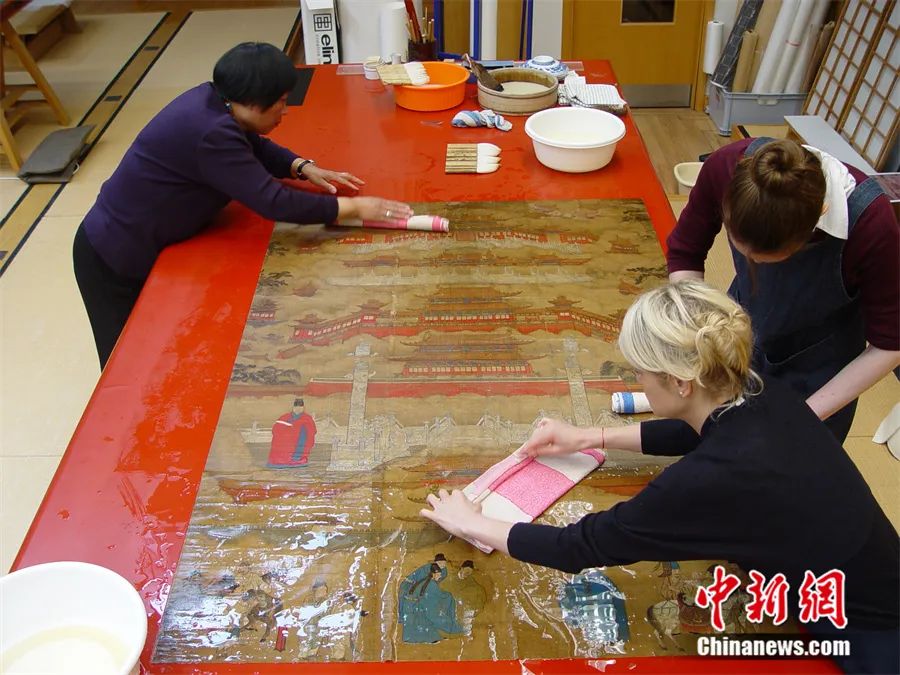
Qiu Jinxian was washing painting with his apprentice. Picture Conferry at the British Museum Custody
China News Agency reporter: Japan's calligraphy and painting mounting technology has a century of inheritance in the UK. Before you go to the Great British Museum, ancient Chinese paintings often repaired in Japanese methods. What is the difference between traditional Chinese ancient painting repair technology and Western technology?
Qiu Jinxian: Japanese calligraphy and painting mounting technology originated from the Tang and Song dynasties of China. For example, the common "shocking swallows" came from the Song style mounting, which is a ribbon attached to the axis. China's ancient painting restoration skills have a long history. Since the Tang Dynasty, "Jingyan" has also changed from "living" to "actual stickers" fixation. As far as silk paintings are concerned, Japan's repair method is biased towards the front of the painting, and the "antique brocade" is mostly used, and the materials are thick. The materials we use are thin, and the painting rolls is softer. We have been replenishing the holes behind the back, adopting the scraping and fine supplement method. After the painting heart is dry, we can scrape the entrance of the hole. Use a brush to brush the clean thick pulp water on the entrance of the hole. Then brush a layer of pulp, scrape it with a horseshoe knife or steel blade, remove the extra tonence. After repairing the silk painting heart, we use silk and dado to make inlaid, and choose the quiet color to match it according to the background color of the painting.
When I went to the Great British Museum, most of the practitioners there were Japanese -style painting skills, without the experience of mounting and repairing ancient Chinese paintings. After seeing my traditional Chinese method mounting ancient Chinese paintings, they will communicate, discuss and learn with me.
Reporter of China News Agency: What difficulties will face in the process of repairing ancient paintings? How to find the materials needed for repairing silk paintings abroad?
Qiu Jinxian: As the saying goes, "The clever woman is difficult to cook without rice." When making up for silk, we require its pattern, structure, paste, and full color to be consistent with the painting. The material of the filling silk is sparse and thick, and the silk is divided into single silk and double silk. Even if the same tonic, the old tonic silk has a long time, compared to the new tonic silk, the luster is darker and the texture is more loose. Finding the material of the silk painting to find a supplement with the same latitudes and weft silk is the key to repairing the seamlessness of the sky. My master gave me a lot of precious silk materials to Britain in order to rescue so many important ancient Chinese paintings. Every time I return to Shanghai, I will also purchase mounting materials for the museum. If you need special materials, I will ask colleagues from the Shanghai Museum to help buy and send it to London. It can be said that behind the glory of ancient calligraphy and painting, many people's efforts are condensed.
Reporter of China News Agency: How do you let the "Girls' History Picture" Tang Yin, Zhu Bang's "Beijing Gongcheng Map" of the Ming Dynasty, and the "Yingxue Reading Map" of the Yuan Dynasty Shengzheng?
Qiu Jinxian: If it is a silk painting, I can first look at the color: if the color is not lost, use hot water to wash it; if the color is fade, wash it with warm water or cold water.
Due to the different degrees of damage and cause, the repair techniques for each calligraphy and painting are not the same. When I first saw the "Female History Phase", the silk and the paper were separated, and the cloth was covered with cracks. Since foreign chemical paste cannot be applied to this millennium ancient painting, I mix it with Japanese starch paste to repair the painting, so that it can keep the viscosity of the painting volume without leaving a trace. It was only completed for more than a month, and the restoration of the "Female History Phase" was preserved for hundreds of years.
The silk "Yingxue Reading Map" of the Yuan Dynasty painter Sheng Yan is a whole silk painting. The painting paper fiber is very "crispy", and there is a obvious crack in the middle of the scroll. So, I chose to make up the holes that I can see with the naked eye, and then slowly penetrate the painting heart with a thick paste, and then use color paper to hold the painting heart.
Qiu Jinxian used the enlarged mirror to add pulp to repair the "Female History". Picture Conferry at the British Museum Custody
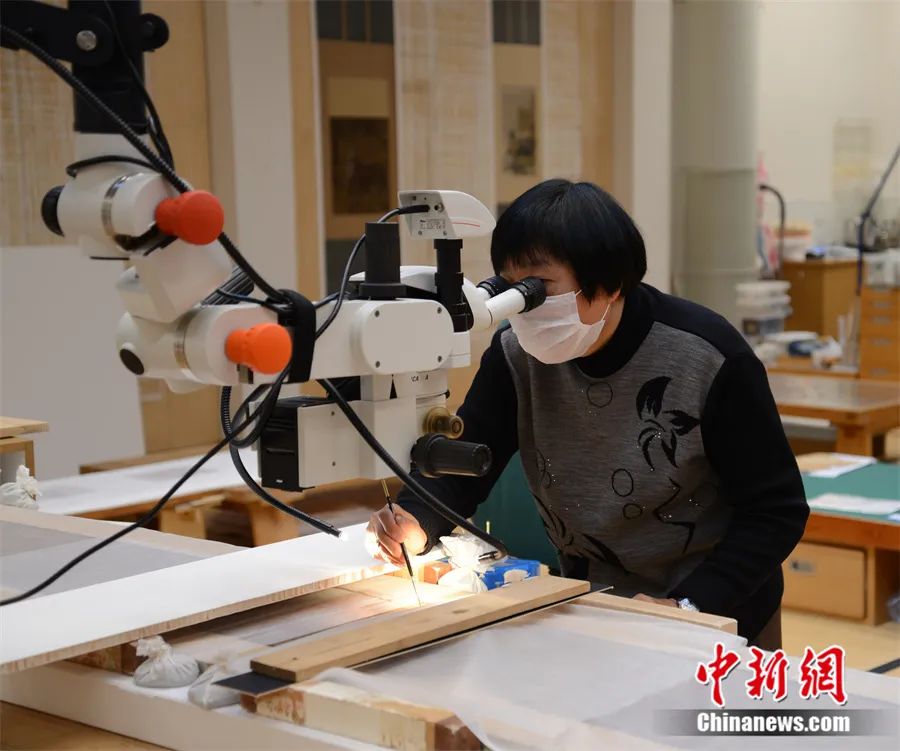
China News Agency reporter: Chinese traditional restoration technology has a history of thousands of years. The process of ancient painting repair is often inherited by teachers and apprentices. How do you teach you the ability to give you a "foreign apprentice"?
Qiu Jinxian: After I went to work in the British Museum, I brought a total of 4 students working at the British Museum, and I also taught many interns from all over the world. In the process of slowly exposed to the repair of ancient Chinese paintings, they are also learning Chinese and understanding Chinese history and culture.
Learning Chinese ancient painting restoration skills are not all overnight. Each piece of calligraphy and calligraphy waiting for repair needs to use different repair processes, so the repair work cannot be standardized, and can only be taught by traditional words. The processes of cleaning, unveiling, supplementation, entrusting, and all the roads need to be practiced from basic skills. The so -called "work is good for good things, it must first benefit its instrument". I will start to teach them from tools such as making steel knives, how to grind knives, and how to fight. Even the simplest paper tailoring moon. Followed by my wrist. China's rice paper fiber is short, and it is easy to break when brushing, so I will ask them to do not leave the hand, repeatedly perform "brushing wall practice", and feel the touch between the pens and the paper to cultivate the "count in the heart, hands in your heart, hands in your heart, hands in your heart, hands in your heart, hands in your hands, hands in your hands, hands in your hands, hands in your hands, hands in your hands, hands in your hands, hands in your hands, hands in your hands, hands in your hands, hands, and hands in your heart. Soft -hardness with a degree. This is a career that requires time precipitation, experience accumulation and patience.
Qiu Jinxian is repairing Zhu Bang's "Beijing Gongcheng Map" in the Ming Dynasty. Picture Conferry at the British Museum Custody
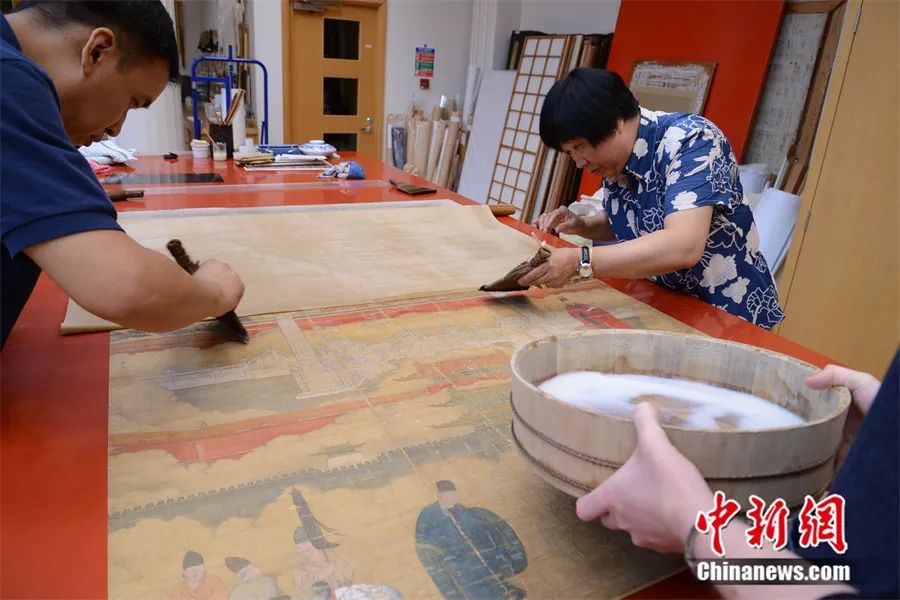
Reporter of China News Agency: The ancient painting repair division is called "painting Langzhong". What do you think of this profession? What do you think is helpful in renovation of cultural relics overseas to enhance Chinese and foreign civilization exchanges and mutual learning?
Qiu Jinxian: Ancient paintings are endless. After I reached the British Museum, Chinese painting slowly had the opportunity to start exhibiting in the showroom, and exhibitions with the theme of Chinese painting will also be held regularly. I want to "rescue" more ancient paintings and extend the life of cultural relics. This is my job and my responsibility. I hope that those once -eye -catching paintings and calligraphy can see the day through my hands and "dialogue" with people who entered the museum, so that the world can feel the Chinese culture hidden in art. At the same time, the relics of cultural relics can be used for scholars to study the economic, cultural, and social development status at that time, which is of great significance to restore history.
Over the years, academic institutions, enterprises or individuals in China, Singapore, the United States and other countries have helped and supported me to repair ancient Chinese paint Better inheritance continues.
From the Shanghai Museum to the British Museum, Professor Rosen said that I set up a bridge for the two museums, deepened friendship, and promoted the collision and exchanges between different cultures of Chinese and Western cultures. In the 35 years I have worked here, I have encountered a lot of interns who come to the museum. They have curiosity and enthusiasm for the restoration of cultural relics. I have taught them and let them feel the "ten years grinding one ten years of grinding one ten years. This is the meaning of the craftsmanship of the sword.
Introduction to the interviewee:
Qiu Jinxian is repairing Zhu Bang's "Beijing Gongcheng Map" in the Ming Dynasty. Picture Conferry at the British Museum Custody
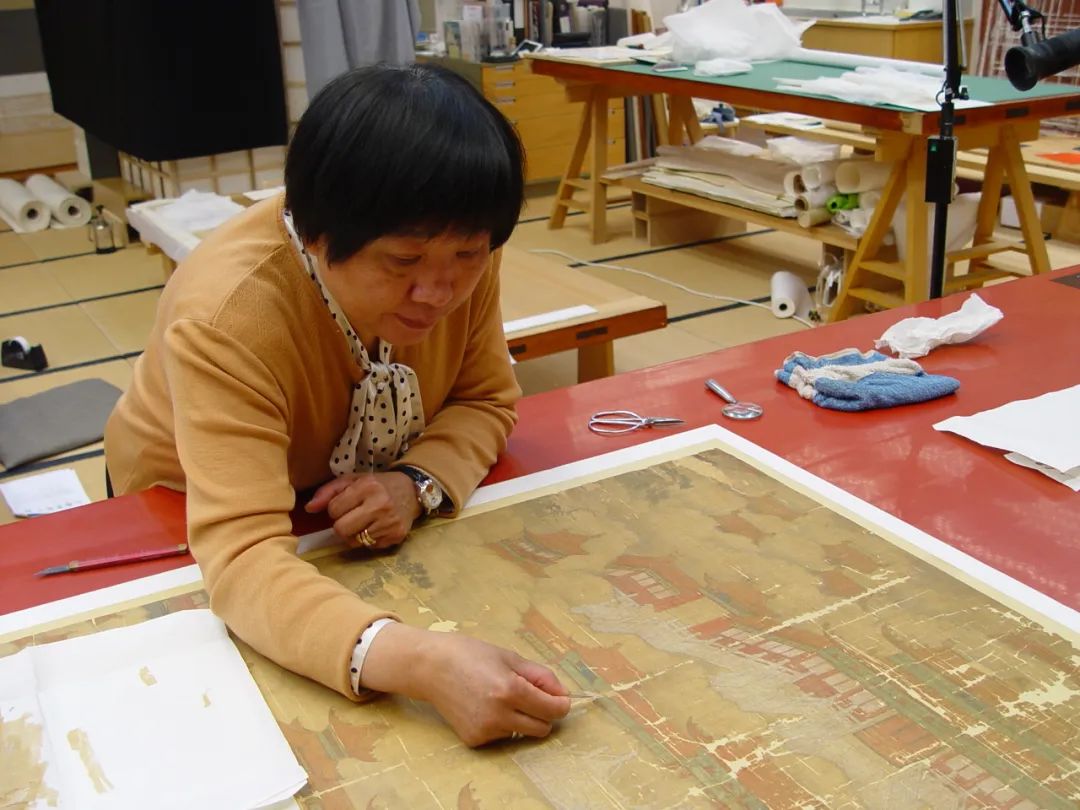
Qiu Jinxian, a Shanghai -native, senior high -level restoration division in the British Museum, joined the Shanghai Museum Mixing Painting Group in 1972, and has served as an ancient Chinese painter in the Greater British Museum in 1987 to this day.In 2002, he cooperated with the Shanghai Museum Crustering Artist Zhu Pinfang to repair Dunhuang paintings collected by the British Museum, which was mounted into 116 pieces; in 2007, the Ming Dynasty famous painter Wu Wei "Nine Tian Xuan Girl Pictures" silk paintings;The set of silk "Yingxue Reading" of the painter of the Yuan Dynasty painter Sheng Yan; in 2013, the silk "Double Horse Map" of the Yuan Dynasty painter Zhao Mengfu and the Ming dynasty painter Zhu Bang's "Ming Dynasty Miyagi Map》 The vertical axis; in 2014, fixed the "Female History Phase" with Japanese colleagues and students.Text Editor: Xu Xueying
Picture Edit: Xiong Ran
- END -
Beijing: Didi took the lead in strengthening the norm of the problem of non -scanning code through technical means

On June 17, at the 368th press conference of the prevention and control of the new...
What kind of children's music series do we need?
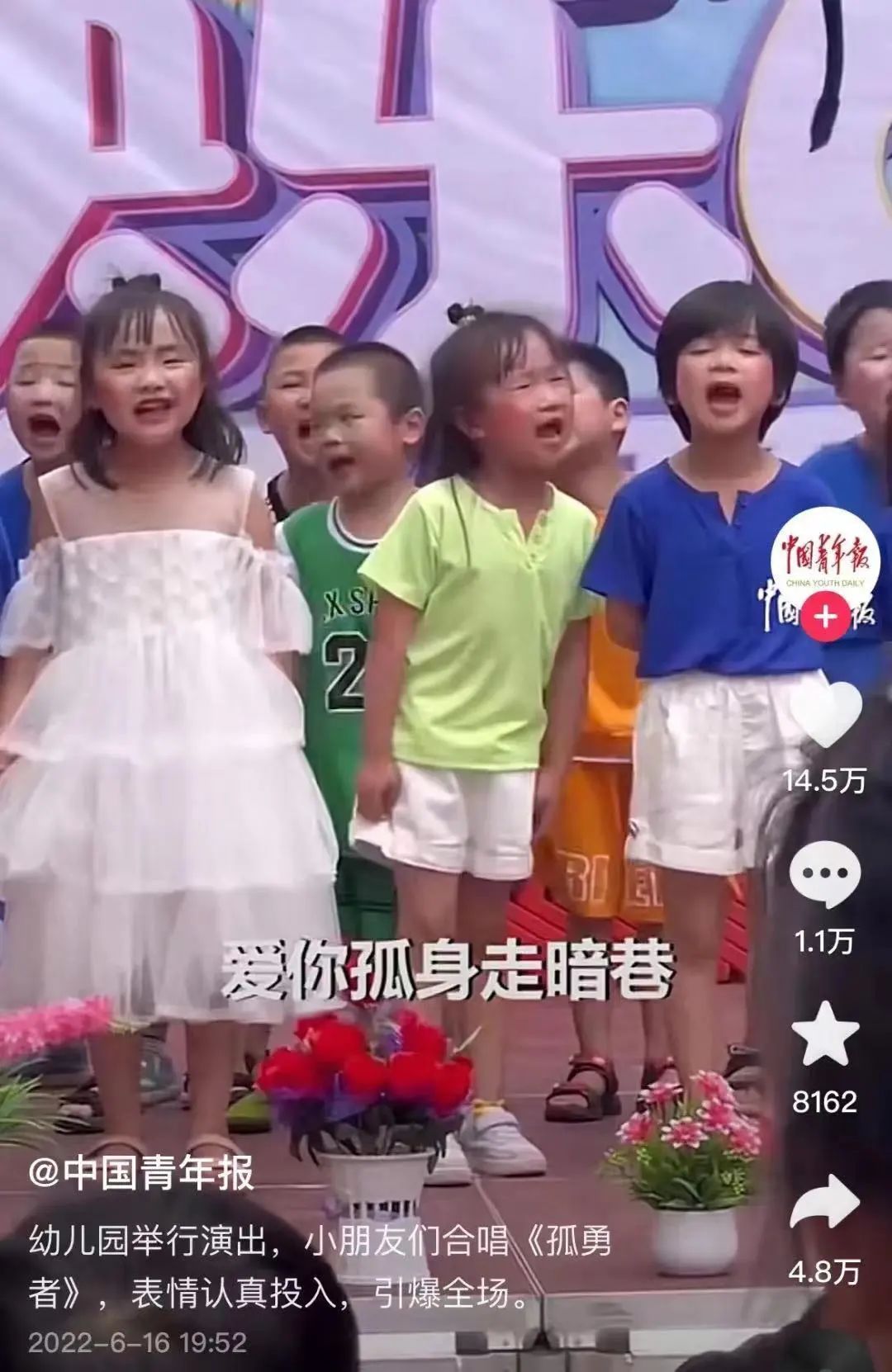
EditorIn recent times, Tang Tian's lyrics, Qian Lei composed, and sang, and the ga...